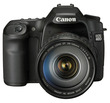Tuesday, August 26. 2008
Canon EOS 50D announced

I was really surprised when I read that Canon itself leaked a webpage describing an EOS 50D! The surprise was due to the usual timespan of 1½ years after which Canon presented a successor of their respective EOS line. As the EOS 40D was presented in fall 2007, I didn’t expect a 50D to come before spring 2009. But probably the 50D came a little earlier to be placed against Nikon’s D300 that really outperforms the 40D.
Having a brief look at the specs I have the impression that it’s rather a minor advance compared to the 40D, fortifying the impression of a pure marketing decision rather than a real technology jump. The significant changes in my eyes are
- 15 MP compared to 10 MP,
- DIGIC IV processor compared to DIGIC III, and
- ISO 12800 max. compared to ISO 3200.
In the end only the last one in that list could be of interest if it implies a lower noise behavior at the same ISO speed. The jump from 30D to 40D was much more significant in my eyes, while that from 20D to 30D was only a cosmetic one in a similar way. However, as there obviously won’t be another successor in spring 2009, I can now be sure that my EOS 40D will stay a top camera for at least another year.
Much more interesting in my eyes is the upcoming EOS 5D
Monday, August 25. 2008
Binary archives in newsgroups

The usenet originally only consisted of text messages, but it soon became a way of exchanging binary files as well. As posts are usually restricted to only a few MB, larger archives have to be split up into several parts, each attached to its own newsgroup posting. But if some parts of these posts aren’t transferred correctly to other usenet hosts, the archive parts are broken.
Not necessarily if the poster created PAR2 archives in addition to the actual data archive parts. In a RAID-like manner, parity information is placed redundantly into the additional files. Thus, it is possible to recover the complete archive if some parts of it are incomplete.
As I downloaded some image archives (No, they were not p’rn) containing pictures in the PCD format that encapsulates six different resolutions of an image, I also had to find out how to explicitly extract the large (3072×2048) resolution out of it. All in all, I created the following (simple) script that
- checks the PAR2 files, and if some of the data archive parts are incomplete, it
- tries to recover them, and
- if check (or recovery) were successful, the PCD images are extracted and converted to JPEG.
I did it this way:
- #!/bin/bash
- # Verify, includes *PAR2 automatically
- par2 v *par2
- ret=$?
- if [ $ret -eq 0 ]; then
- # Extract
- unrar x *part01.rar
- cd “$(find -type d | tail -n 1)”
- # Convert
- for file in *PCD; do
- echo -n “$file ”
- convert $file[5] $(basename $file .PCD).jpg && rm $file
- done
- echo Done.
- elif [ $ret -eq 1 ]; then
- echo “PARITY CHECK FAILED, TRYING TO REPAIR.”
- sleep 2
- # Repair, if needed
- par2 r *par2 && echo “You may now rerun this script.”
- else
- echo “REPAIR NOT POSSIBLE.”
- fi
Thursday, August 14. 2008
Digitale Bilder organisieren

Obwohl ich schon einmal hier laut darüber nachgedacht habe, wie ich meine (digitalen) Fotos organisieren soll, reagiere ich nun auf eine Blogparade zu diesem Thema, auch um mich selbst etwas mehr zur Fotografie anzuspornen.
- Auf wie vielen Datenträgern speicherst Du Deine Fotos?
Auf drei bis vieren: Eventuell parke ich sie nämlich schon unterwegs auf dem Datentank. Danach habe ich eine Drei-Zeiträume-Strategie: Solange Platz ist, sind die aktuelleren Fotos am Notebook, zur Bearbeitung und zum schnellen Zugriff. Dann werden alle Fotos gemeinsam mit weiteren persönlichen Daten auf einen Backup-PC synchronisiert, der aber wohl bald durch ein USB- oder FireWire-Festplattenarray ersetzt wird; dort sollen sich alle bisher gemachten Fotos befinden. Zuletzt landen die Fotos zur Katastrophenvorbeugung auf DVD-RAMs (nicht CDs und nicht DVD-R(W)s), da diese relativ lange physikalisch haltbar sind; diese werden außer Haus gelagert. Darüber hinaus werden die besten Bilder schlicht ausgearbeitet. - Wie regelmäßig machst du Backups?
Neue Fotos werden sofort aufs Backupmedium synchronisiert. Monatlich kommen sie auf DVD-RAM. Sobald eine DVD-RAM voll ist, verlässt sie das Haus. - In welchem Format speicherst du deine Fotos?
In dem, in dem sie aus der Kamera kommen, d.h. RAW oder JPEG. Bearbeitungen werden immer als separate JPEGs gespeichert; TIFFs habe ich bisher noch nicht benötigt. Nicht überzeugende Fotos werden sowieso gnadenlos gelöscht. - Welche Ordnerstrukturen oder Dateinamen verwendest Du?
Bisher lege ich die Ordner einfach in der Form YYYY/MM/DD_Thema an, die Dateinamen bleiben die aus der Kamera. Ableitungen erhalten ein Suffix. - Wie indizierst Du Deine Fotos?
Mit digiKam. Allerdings fühle ich in letzter Zeit keinen Bedarf dafür. - Welche Software setzt du ein?
Ich bin sehr hart im Nehmen, setze nämlich zu 100% Linux-Software ein. digiKam verwende ich zum Taggen und Aussortieren, GIMP zur klassischen Bildbearbeitung, Bibble Pro zur RAW-Konvertierung, QtpfsGUI zum HDR-Berechnen, und schließlich das Triplett aus Hugin, Autopano-SIFT und Enblend zur Erstellung von Panoramabildern. Desweiteren besitze ich eine Noise Ninja-Lizenz. Unter den Linuxern gehöre ich also zu den Pragmatikern, die nicht ausschließlich freie Software benutzen. Das Backup selbst fahre ich mit rsync.